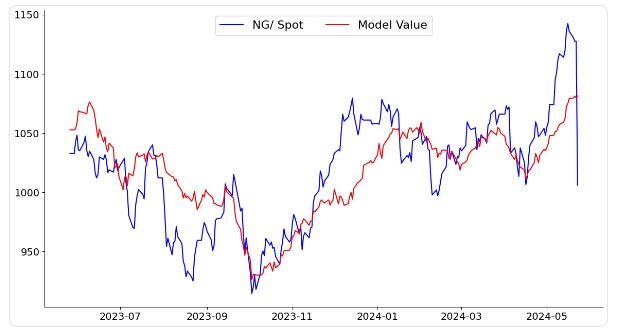eyeQ: National Grid – macro vs micro
interactive investor has teamed up with the experts at eyeQ who use artificial intelligence and their own smart machine to analyse macro conditions and generate actionable trading signals. Here’s what it makes of this energy firm’s price slump.
23rd May 2024 13:03
by Huw Roberts from eyeQ

"Our signals are crafted through macro-valuation, trend analysis, and meticulous back-testing. This combination ensures a comprehensive evaluation of an asset's value, market conditions, and historical performance." eyeQ
- Discover: eyeQ analysis explained | eyeQ: our smart machine in action | Glossary
National Grid
Trading signal: long-term strategic model
Model value: 1,082.53p
Fair Value Gap: -3.15% discount to model value
Model relevance: 74%
Data correct as at 23 May 2024. Please click glossary for explanation of terms.
We’re biased. Macro dominates the world of investing. But there are times when it’s clear that company news is the key driver of share prices.
National Grid (LSE:NG.) has just announced plans for a big (£6.8 billion) capital raise to fund a huge investment programme to help the UK’s shift to net zero. The idea is to spend around £60 billion overhauling the grid to enable it to connect to renewable power sources and electric vehicle (EV) networks; plus general infrastructure work to facilitate what could be a doubling of electricity demand as the economy moves to decarbonise.
The financing of this investment comes at the cost of existing shareholders. Hence a sharp 8%+ fall when the news broke.
That has taken National Grid shares cheap to our macro valuations. Model value on eyeQ (i.e. where the stock “should” trade given overall macro conditions such as economic growth, inflation, etc) is 1,083p. And note our macro relevance score is 74%. So macro does matter here.
So yes, in the near term the financial engineering required to fund this investment programme is a big drag. And how analysts respond and revise their target prices will be critical. Bottom-up stock analysis is vital for anyone involved or looking to get involved in the stock.
But macro matters too and the trend to macro is positive. Model value has risen 5.3% over the last month alone.
The Fair Value Gap isn’t yet big enough to trigger a bullish signal. That, plus the need to let the dust settle after the rights issue, is enough to keep us sidelined. But it’s an interesting one to watch and a nice tactical entry level could be building in a long-term investment theme given National Grid will play a pivotal role in the UK’s shift to net zero.

Source: eyeQ. Past performance is not a guide to future performance.
Useful terminology:
Model value
Where our smart machine calculates that any stock market index, single stock or exchange-traded fund (ETF) should be priced (the fair value) given the overall macroeconomic environment.
Model (macro) relevance
How confident we are in the model value. The higher the number the better! Above 65% means the macro environment is critical, so any valuation signals carry strong weight. Below 65%, we deem that something other than macro is driving the price.
Fair Value Gap (FVG)
The difference between our model value (fair value) and where the price currently is. A positive Fair Value Gap means the security is above the model value, which we refer to as “rich”. A negative FVG means that it's cheap. The bigger the FVG, the bigger the dislocation and therefore a better entry level for trades.
Long Term model
This model looks at share prices over the last 12 months, captures the company’s relationship with growth, inflation, currency shifts, central bank policy etc and calculates our key results - model value, model relevance, Fair Value Gap.
These third-party research articles are provided by eyeQ (Quant Insight). interactive investor does not make any representation as to the completeness, accuracy or timeliness of the information provided, nor do we accept any liability for any losses, costs, liabilities or expenses that may arise directly or indirectly from your use of, or reliance on, the information (except where we have acted negligently, fraudulently or in wilful default in relation to the production or distribution of the information).
The value of your investments may go down as well as up. You may not get back all the money that you invest.
Equity research is provided for information purposes only. Neither eyeQ (Quant Insight) nor interactive investor have considered your personal circumstances, and the information provided should not be considered a personal recommendation. If you are in any doubt as to the action you should take, please consult an authorised financial adviser.
Disclosure
We use a combination of fundamental and technical analysis in forming our view as to the valuation and prospects of an investment. Where relevant we have set out those particular matters we think are important in the above article, but further detail can be found here.
Please note that our article on this investment should not be considered to be a regular publication.
Details of all recommendations issued by ii during the previous 12-month period can be found here.
ii adheres to a strict code of conduct. Contributors may hold shares or have other interests in companies included in these portfolios, which could create a conflict of interests. Contributors intending to write about any financial instruments in which they have an interest are required to disclose such interest to ii and in the article itself. ii will at all times consider whether such interest impairs the objectivity of the recommendation.
In addition, individuals involved in the production of investment articles are subject to a personal account dealing restriction, which prevents them from placing a transaction in the specified instrument(s) for a period before and for five working days after such publication. This is to avoid personal interests conflicting with the interests of the recipients of those investment articles.